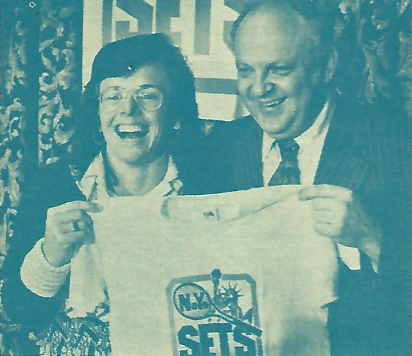“The condition of man,” wrote Thomas Hobbes, “is a condition of war of everyone against everyone.”
Ah, so Hobbes was a tennis fan.
In 1972, the International Lawn Tennis Federation finally made its peace with World Championship Tennis, the deep-pocketed tournament circuit based in the United States. As soon as that agreement was reached, a new antagonist entered the scene in the form of the Association of Tennis Professionals, the players’ union that was now threatening the sport with a boycott at the biggest event of them all, Wimbledon.
In April 1973, the USLTA came to terms with the rival Virginia Slims circuit. Same story: The truce led to the formation of the Women’s Tennis Association.
The 1973 tennis calendar was a fragile thing. Promoters world-wide–and especially in the States–competed to attract the biggest stars of the game, often in pursuit of television contracts. Some of the upstarts were sanctioned; others didn’t care. There were more would-be tournaments and exhibitions than there were weeks to hold them or marquee names to play them.
And then it got worse. On June 22, 1973, Jerry Saperstein–best known as the former owner of basketball’s barnstorming Harlem Globetrotters–announced the formation of the World Team Tennis League. The 16-team circuit would begin play in May 1974.
The plan was audacious beyond belief. Modern fans know World Team Tennis as a laid-back series of summer exhibitions, a sideshow that rarely takes a top player away from any sanctioned tournament worth entering. Saperstein and his associates were thinking bigger. Teams would play forty-four matches between May and July.
In the understatement of the year, the promoter acknowledged that a few other tennis events took place during those months: “Obviously there will be conflicts, but we’ll do anything within reason to accommodate the existing tournaments.” In practice, that meant two weeks off for Wimbledon, and the rest of the existing slate could fend for itself.
The big question was whether the players would buy in. The league would need around 100 athletes, and Saperstein expected the number one man and the number one woman to sign up. (He didn’t name names, perhaps diplomatically, because both titles were up for grabs.) WTT staffers headed to London to talk up the venture. Tabling boycott-related matters, ATP leaders discussed how they should approach the new venture. Stan Smith, one of the league’s top targets, was skeptical.
Most negative of all, however, were the Brits. To many on the island, the Wimbledon boycott wasn’t the fault of an imperious power structure, or even the ATP. They blamed the Americans–or, more specifically, American money. Jack Kramer had lured the world’s best into his professional ranks for decades. Lamar Hunt signed big checks that kept stars jetting around the States for months at a time. And now, a consortium of US team owners (okay, well, John Bassett was ready to put a team in Toronto) were taking aim at the British summer season and perhaps even Wimbledon itself.
“‘Team Tennis’,” wrote David Talbot of the Birmingham Post, “will be a travesty of lawn tennis.”
It would be different, that much was certain. Several prospective owners were also involved in the upstart World Hockey Association, and the league would target a demographic that was less country club, more hockey fan. On court, WTT squads would play no-ad games, change sides only after each set, and allow mid-match substitutions.
Would it work? Saperstein, whose New York franchise would play at Madison Square Garden, admitted, “This is like rolling craps–we’ll lose money the first year.” Profitable or not, World Team Tennis would offer a challenge to the tennis establishment that would make the Wimbledon boycott seem like a mere bump in the road.
* * *
This post is part of my series about the 1973 season, Battles, Boycotts, and Breakouts. Keep up with the project by checking the TennisAbstract.com front page, which shows an up-to-date Table of Contents after I post each installment.
You can also subscribe to the blog to receive each new post by email:
